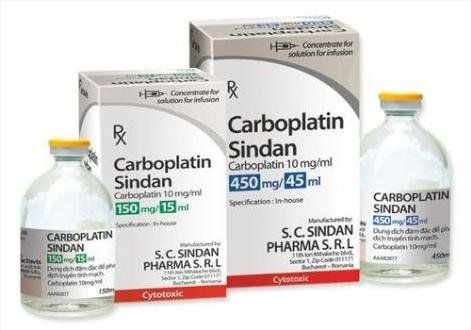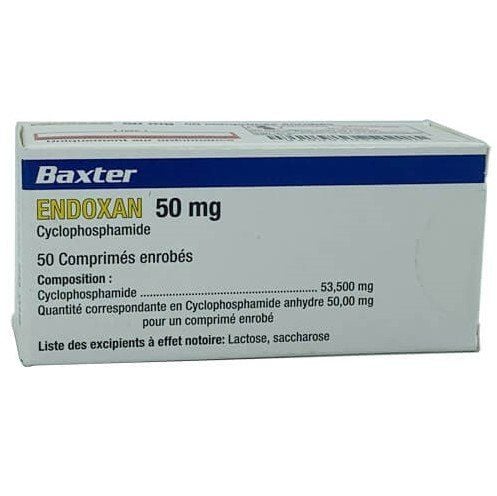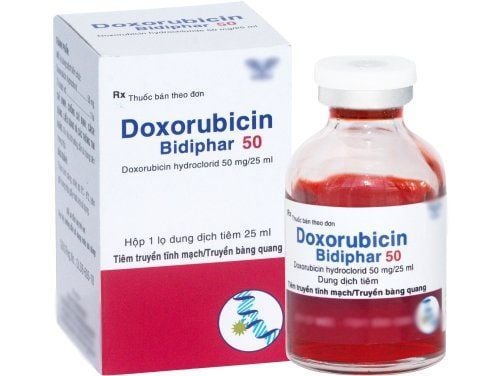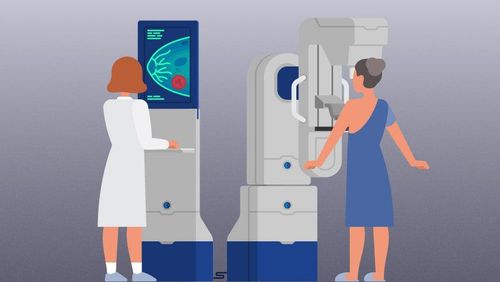This is an automatically translated article.
Article by Dr. Hoang Quoc Chinh - Medical Genetics Division, Vinmec High-Tech Center
Hereditary Breast and Ovarian Cancer (HBOC) is a syndrome that increases the risk of certain types of cancer and begins at a younger age than the population average. HBOC carriers have an increased risk of breast, ovarian, and certain other cancers.
1. Causes of HBOC . syndrome
HBOC syndrome is caused by the inactivation (mutation) of genes involved in repairing damage to the genome. When these genes are mutated, the ability of the genome to repair abnormalities is completely or partially lost, thereby leading to the accumulation of mutations in the cell. If, unfortunately, these mutations occur in genes that cause cancer, the cells carrying the mutation will be converted into cancer cells. Cancer cells continuously grow, develop and form tumors.
Hình 1: Hiệu ứng Angelina. Sau khi phát hiện mình mang đột biến di truyền trên gen gây ra hội chứng HBOC, Angelina đã quyết định phẫu thuật vú và buồng trứng để giảm nguy cơ mắc bệnh ung thư của mình. Hưởng ứng lời kêu gọi của cô, rất nhiều phụ nữ trên thế giới đã thực hiện xét nghiệm gen để đánh giá nguy cơ mắc bệnh ung thư của mình. (Ảnh từ internet).
HBOC syndrome is an inherited disease caused by a genetic mutation. This means that factors that increase the risk of cancer are passed down from generation to generation in a family. Mutations in the BRCA1 and BRCA2 genes are the most common cause of HBOC syndrome. Females with mutations in the BRCA1 and BRCA2 genes have a higher risk of developing breast and ovarian cancer than the general population. Men with mutations in these two genes also have an increased risk of breast and prostate cancer. Mutations in these two genes also slightly increase the risk of other cancers. Diseases adjacent to BRCA1 and BRCA2, mutations in other genes such as TP53, PTEN, CDH1, ATM, CHEK2, or PALB2 are also responsible for this syndrome.
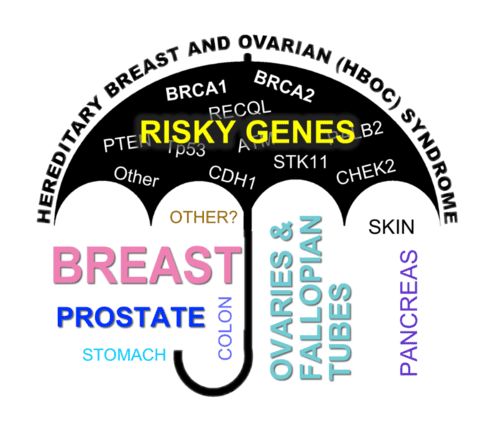
Hình 2: Gen gây ra HBOC và các bệnh ung thư liên quan. Genes: BRCA1, BRCA2, PTEN, TP53, CDH1, STK11, CHEK2... Breast: ung thư vú. Prostate: ung thư tuyến tiền liệt. Stomach: ung thư dạ dày. Ovarian: ung thư buồng trứng. Pancreas: ung thư tuyến tụy. Skin: ung thư da. https://www.hbocsociety.org
HBOC syndrome has no characteristic appearance, thus cannot be detected through routine physician examination. The diagnosis of hereditary breast and ovarian cancer syndrome is made only through analysis of the genes involved in this syndrome.
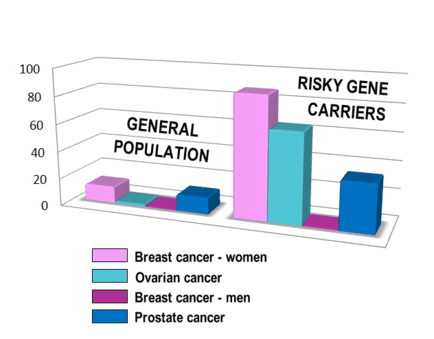
Hình 3: Nguy cơ mắc bệnh ung thư của quần thể và người mang đột biến gen. General population: quần thể (tất cả mọi người). Risky gene carriers: người mang đột biến di truyền trên gen gây ra hội chứng HBOC. Breast cancer – women: ung thư vú ở nữ giới. Ovarian cancer: ung thư buồng trứng. Breast cancer – men: ung thư vú ở nam giới. Prostate cancer: ung thư tuyến tiền liệt. https://www.hbocsociety.org/
2. Who should perform the test?
Each person's cell has two copies of a gene; One copy is inherited from the father and the other copy is inherited from the mother. HBOC syndrome is a dominantly inherited syndrome, meaning that just one copy of the faulty gene is enough to cause the syndrome. During fertilization, the zygote (the mother cell of an organism) can receive a faulty copy or a normal copy from either parent if either parent is a carrier of the genetic mutation. This means that the father, mother, brother, sister, and biological child of a carrier of the genetic mutation have a 50% chance of carrying the same type of mutation (Figure 3).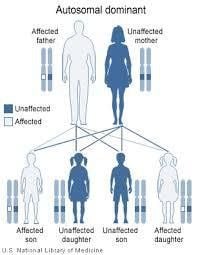
Hình 4: Phương thức di truyền của những gen gây ra HBOC. Affected: người mang đột biến di truyền trên một bản sao của gen. Unaffected: người không mang đột biến di truyền. https://myriadmyrisk.com
In the family there is a carrier of genetic mutations in genes that increase the risk of cancer Patients with breast cancer diagnosed aged 45 years or younger Patients with breast cancer, and a family history of the disease cancer Patients with breast cancer with a “triple negative” and diagnosed at age 60 or younger. Cancer in both breasts or ovaries. Patients with ovarian cancer, male breast cancer, metastatic pancreatic or prostate cancer. The BRCA1/2 gene mutation was detected in the tumor.
3. Methods to reduce risk
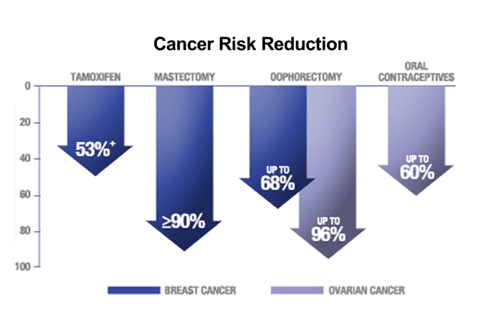
Hình 5: Tỷ lệ giảm nguy cơ mắc ung thư vú và buồng trứng ở người có nguy cơ cao. Breast cancer: ung thư vú. Ovarian cancer: ung thư buồng trứng. Tamoxifen: uống tamoxifen. Mastectomy: phẫu thuật loại bỏ hai bên vú. Oophorectomy: phẫu thuật buồng trứng. Oral contraceptives: uống thuôc tránh thai. https://www.hbocsociety.org/
Surgery to remove both breasts can reduce the risk of breast cancer by up to 90%. Only about 3% of breast cancer patients with an inherited mutation in the BRCA1 or BRCA2 gene are diagnosed before age 30, so women with an inherited mutation in the BRCA1 or BRCA2 gene may consider surgery after age 30.
Removal of the ovaries and fallopian tubes can reduce the risk of ovarian cancer by 90 and the risk of breast cancer by 50%.
Since containment surgery is an invasive and irreversible procedure, the decision to perform containment surgery should be carefully considered. Doctors and genetic counselors can provide information about the benefits and risks based on your health, type of mutation, and family history, but cannot make decisions for you.
Drugs reduce the risk.
Certain drugs can help reduce the risk of cancer. Example: Women at high risk who take Tamoxifen for 5 years can reduce their risk of breast cancer by 50%. Similarly, raloxifene (Evista) and aromatase inhibitors (AIs) may also reduce the risk of breast cancer in high-risk individuals. However, the risk-reducing effect of these drugs in gene mutation carriers has not been elucidated.
Taking birth control pills for 5 years can reduce the risk of ovarian cancer by 50% for BRCA1 or BRCA2 gene mutations.
Maintain a healthy lifestyle.
Practicing a healthy lifestyle, including “eating right, getting enough sleep, exercising regularly, staying away from stress and stimulants, and maintaining BMI < 23 kg/m2), is an effective way to reduce risk most effective and effective not only for cancer but also for most chronic diseases.
Currently, Vinmec International General Hospital is the first medical facility in Vietnam capable of implementing cancer screening by combining 4 technologies: genetic testing, endoscopy, ultrasound and laboratory testing. immunity. In which, cancer screening with gene technology is a method that is considered a breakthrough in medicine.
Early screening is considered the "golden key" to detect and provide prevention methods, reduce the risk of death and costs for patients. Due to late detection (70% of patients are treated when they are at the end stage), the death rate from cancer in Vietnam is very high. To register for examination and treatment at Vinmec International General Hospital, you can contact the nationwide Vinmec Health System Hotline, or register online HERE.




